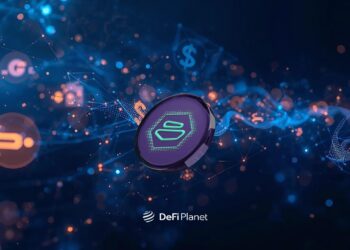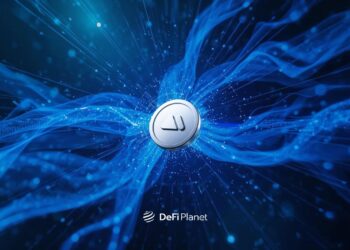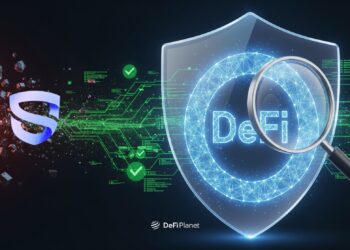In the decentralized world of Web3, smart contracts need access to real-world data to function correctly. That’s where oracles come in. Among the most talked-about oracles today are Pyth Network and Chainlink—both play critical roles in connecting blockchains to external data, but they do so in fundamentally different ways.
Let’s break down what Pyth Network is, how it works, and when it comes to Pyth Network vs Chainlink, how do they compare in areas like data quality, latency, decentralization, and real-world applications in DeFi?
What is Pyth Network and How Does It Work?
Pyth Network is a decentralized oracle solution built to deliver fast, reliable, and high-frequency market data to blockchains. Launched in 2021 and originally deployed on the Solana blockchain, Pyth was designed with a clear mission: to bridge the gap between traditional financial data providers and decentralized applications (dApps), especially in the DeFi space.
What sets Pyth Network apart is its commitment to first-party data sourcing. Rather than depending on third-party aggregators, Pyth taps directly into the source. It gathers price information from major financial institutions, trading firms, and exchanges—the very entities that generate the data. This direct connection helps ensure that the information is timely and accurate. So, when people ask, “Is Pyth Network better than Chainlink?”, this is one of the key points in its favour.
Here’s how it all comes together: these first-party publishers continuously send their pricing data to Pyth. Each submission includes not only the price but also a confidence interval, which represents how sure the provider is about the accuracy of their data at that moment.
Once the data arrives, Pyth’s system aggregates it using a weighted average method. This means it prioritizes more trustworthy sources and filters out any extreme or unreliable values. The result is a strong, consensus-driven price feed that updates roughly every 400 milliseconds—perfect for use cases like high-speed trading, decentralized lending, and other applications that demand real-time precision.
Another standout feature is Pyth’s pull-based model. Instead of constantly pushing data on-chain (which can be costly and congest the network), Pyth only publishes data when it’s requested. This approach significantly reduces transaction fees and on-chain noise, making it more efficient and developer-friendly.
What is Chainlink and How Does It Work?
Chainlink is one of the most well-known decentralized oracle networks in the blockchain world. Its main job is to help smart contracts access real-world data like prices, weather updates, etc., in a secure and reliable way. Since blockchains can’t reach outside their own networks on their own, Chainlink acts as a bridge between on-chain and off-chain worlds.
At the core of Chainlink’s system is a network of independent oracle nodes. Think of these oracles as digital messengers: they go out into the real world, collect data from multiple trusted sources, and bring that information back to the blockchain. Once enough oracles have gathered the same type of data Chainlink aggregates their responses into one final, verified result and delivers it to the smart contract that needs it.
Unlike Pyth Network, Chainlink typically uses a third-party data approach. Its nodes pull information from data aggregators like CoinMarketCap and CoinGecko and then deliver a consensus-based output to smart contracts. Each oracle signs its data, ensuring authenticity and traceability.
One of Chainlink’s strengths is its cross-chain compatibility—it works on Ethereum, Polygon, and beyond. This broad reach leads some to ask: “What is better than Chainlink?” For multi-industry use cases, few oracles match its versatility.
Chainlink also adds several layers of protection to keep things secure. Each oracle signs its data with a unique digital signature, so users can verify exactly where it came from. Plus, its flexible design allows developers to build custom oracle networks that fit their specific needs—whether it’s for gaming, insurance, or supply chain tracking.
One of Chainlink’s biggest strengths is that it works across all kinds of blockchains. Whether it’s Ethereum, Polygon, or any other network, Chainlink can plug in and start delivering external data without being tied to just one system.
Pyth Network vs Chainlink: Key Differences
Both Pyth Network and Chainlink are vital pieces of the Web3 infrastructure puzzle, but they’re designed with different priorities in mind. Think of them like two chefs in a kitchen—both talented, but one specializes in gourmet finance, while the other can whip up a variety of dishes across every cuisine. Let’s break down their key differences in simple terms:
1. Where the Data Comes From
One of the biggest differences lies in who provides the data. Pyth Network gets its information straight from the source—top financial institutions, trading firms, and exchanges. This is known as a first-party model. It’s like getting your market prices directly from the stock exchange floor.
Chainlink, on the other hand, relies on a network of node operators who often fetch data from aggregator platforms like CoinGecko or CoinMarketCap. This makes it more third-party driven, diverse, but sometimes slower and less consistent, especially for fast-moving financial data.
2. Push vs. Pull: How the Data Is Delivered
Pyth uses a pull model. That means data is published only when someone requests it. This keeps things lean, saves gas fees, and ensures that updates happen exactly when needed. It’s perfect for high-speed environments like trading platforms and lending protocols.
Chainlink utilises a push model, where data is automatically sent on-chain at regular intervals or when specific conditions are met, such as a price moving up or down by a certain percentage. This is more predictable and reliable for general use, but can lead to unnecessary updates (and extra costs) when precision or speed isn’t the top priority.
3. Transparency and Community Involvement
Pyth is governed by a DAO (Decentralized Autonomous Organization), meaning decisions about upgrades, fees, and protocol changes are made with input from its community. Plus, all its data aggregation happens on-chain, so anyone can verify how the final price was calculated.
Chainlink also promotes community participation, but it has been criticized for relying on multisig control, where a small group can manage critical parts of the system. Its data aggregation typically happens off-chain, so it’s not always immediately visible how the final number came to be.
4. Who They’re Built For
Pyth is laser-focused on DeFi and financial applications. If you’re building a decentralized exchange, lending app, or anything that needs super-accurate, real-time prices, Pyth is your guy.
Chainlink is more of a generalist. It supports DeFi too, but it also branches out into insurance, gaming, NFTs, and supply chain solutions. Its flexibility makes it attractive to developers across many industries.
5. Speed and Accuracy
Because Pyth is designed for finance, its price updates are lightning fast—updated every few hundred milliseconds. This makes a big difference for protocols where a price delay could mean a big loss or a missed opportunity.
Chainlink updates a little slower—every few seconds or minutes, depending on the setup. That’s still fast enough for most applications, but not ideal for high-frequency traders or liquidation-sensitive systems.
This makes a compelling case for those wondering, “Is Pyth Network better than Chainlink?“—at least for real-time DeFi needs.
A Table Comparing Pyth Network Vs Chainlink
Pyth Network Vs Chainlink
Feature | Pyth Network | Chainlink |
| Data Source | First‑party (direct from institutions/exchanges) | Third‑party (node operators sourcing from aggregators) |
| Delivery Model | Pull (on‑demand updates) | Push (scheduled or condition‑triggered updates) |
| Transparency & Governance | On‑chain aggregation, DAO‑driven decisions | Off‑chain aggregation, multisig‑controlled updates |
| Primary Focus | High‑frequency DeFi & financial data | General‑purpose oracle services (DeFi, gaming, insurance, etc.) |
| Update Speed | 300–400 ms | Seconds to minutes |
Use Cases in DeFi, Trading, and On-Chain Finance
Both Pyth Network and Chainlink play pivotal roles in the decentralized finance (DeFi) ecosystem, each offering unique strengths across various applications. Here’s a closer look at how they contribute to different sectors:
Decentralized Exchanges (DEXs)
- Pyth Network: Pyth provides ultra-fast and precise price feeds, crucial for DEXs that require real-time data. For instance, Helix is a decentralized order book exchange for spot and derivatives trading. By leveraging Pyth’s low-latency price feeds, Helix can efficiently calculate funding rates for its derivatives markets, ensuring accurate pricing and risk management.
- Chainlink: Chainlink offers secure and reliable price feeds for automated market makers (AMMs) like Sushiswap and Uniswap. These feeds enable accurate pricing and execution of trades, supporting a wide range of trading pairs and ensuring the integrity of the trading process.
Lending Platforms
- Pyth Network: In lending protocols, accurate asset pricing is vital. Platforms like Solend utilize Pyth’s real-time data to monitor users’ account health and determine liquidation events, thereby maintaining the platform’s stability and protecting lenders
- Chainlink: Chainlink’s price feeds are integral to lending platforms such as Aave, Compound, and MakerDAO. They provide up-to-date collateral valuations, enabling these platforms to manage loan-to-value ratios effectively and automate key functions, such as liquidations.
Stablecoins
- Pyth Network: Stablecoin protocols rely on Pyth’s frequent and accurate price updates to maintain their pegs to fiat currencies. This is essential for ensuring the stability and trustworthiness of stablecoins like USDt, particularly during volatile market conditions.
- Chainlink: Chainlink supports stablecoins by providing reliable price feeds and proof-of-reserve mechanisms. These tools help verify that stablecoins are fully collateralized, thereby maintaining their peg and ensuring transparency for users.
Yield Farming & DeFi Optimizers
- Pyth Network: In yield farming, timely data is crucial for optimizing returns. A risk-adjusted yield protocol, qPools employs Pyth’s price data to calculate the value of its QPT token relative to its reserves. This ensures accurate valuation and enhances the protocol’s ability to provide optimized yields across various DEXs. .
- Chainlink: Chainlink’s Automation services enable DeFi platforms to automate reward distributions and other critical functions. This reduces the need for manual intervention, increases efficiency, and ensures that users receive timely and accurate rewards.
When considering Pyth Network vs Chainlink, each proves essential in different corners of the DeFi ecosystem.
Final Thoughts: Which Oracle Is Right for You?
The answer isn’t cut and dry. Some might ask, “What is better than Chainlink?“—but it really depends on your use case. If your project relies on ultra-low-latency, finance-grade data, Pyth Network is a strong contender. But if you need versatility across a range of off-chain inputs and networks, Chainlink still stands tall.
Ultimately, when facing the question “Is Pyth Network better than Chainlink?”, it’s not about declaring a single winner. It’s about finding the oracle that fits your project like a glove.
Whether you’re researching What is Chainlink? for the first time or trying to understand What is Pyth Network?, this comparison should equip you to make a well-informed decision.
Disclaimer: This article is intended solely for informational purposes and should not be considered trading or investment advice. Nothing herein should be construed as financial, legal, or tax advice. Trading or investing in cryptocurrencies carries a considerable risk of financial loss. Always conduct due diligence.
If you want to read more market analyses like this one, visit DeFi Planet and follow us on Twitter, LinkedIn, Facebook, Instagram, and CoinMarketCap Community.





















